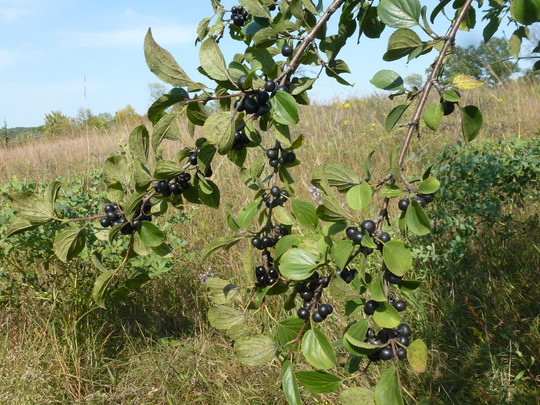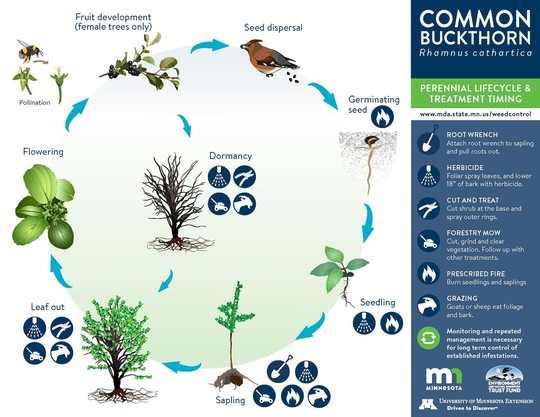|
Having trouble viewing this email? View it as a Web page.
February 9, 2021
February Weed of the Month: Tactical Plan for Invasive Plant Prioritization
Monika Chandler, Minnesota Department of Agriculture
Invasive plant problems in Minnesota can feel overwhelming. One example is common buckthorn (Rhamnus cathartica). Common buckthorn is an invasive tree or shrub that crowds out forest understories. When forests understories are shaded by common buckthorn, native tree saplings and wildflowers don’t regenerate. Additionally, soybean aphids overwinter on buckthorn thereby maintaining soybean aphid populations.
 Common buckthorn fruit contains seed. Birds eat the fruit and can spread the seed.
Click here to download the image
Unfortunately, common buckthorn is abundant in many areas of Minnesota. It is cost-prohibitive and not feasible to control all of the buckthorn at once. Should we give up and say that there is nothing we can do about invasive plants that are abundant? A better approach is to decide what we can do and figure out how to maximize the benefits of buckthorn control. Maximizing benefits and reducing negative impacts are the focus of the newly developed Tactical Invasive Plant Management Plan.
 This map shows prioritization for common buckthorn treatments. Areas that are the highest priority are shown in yellow. Areas of medium priority are shown in green. Areas of low and lowest priority are shown in medium and dark blue respectively.
Click here to download the image
Using invasive plant distribution and economic modeling by the University of Minnesota Extension, the Minnesota Department of Agriculture (MDA) and many other partners developed a plan to prioritize management of buckthorn and other invasive plant species. Information from distribution models, confirmed reports, economic benefits, land cover, proximity to areas of high biodiversity (conservation priority) and proximity to trails were analyzed to develop the prioritization maps. The highest priority areas are in yellow. One example is that there are no confirmed buckthorn reports in Cook County (Grand Marais area), yet there are many areas important to forestry, conservation, and recreation. It makes sense to limit the spread of buckthorn into Cook County and other areas with low infestation density. The plan established priorities for different regions of the state.
 This graphic shows the lifecycle and treatment timing for common buckthorn.
Download the image or a pdf document
Successful invasive plant management depends on applying proper treatments at the appropriate plant growth stage. Treatment information was pulled together in visuals of each species lifecycle and treatment timing. These lifecycle graphics and other materials developed for this project are available to the public and may be reproduced for educational purposes.
By correctly controlling invasive plants in priority areas, we can maximize outcomes. To learn more about the Tactical Plan, visit the MDA website. To learn about invasive plants and see their distribution, density, and management prioritization, explore our Tactical Plan GIS hub. You can find and download the lifecycle graphics at the GIS hub.
We gratefully acknowledge project support from the Environment and Natural Resources Trust Fund as recommended by the Legislative-Citizens Commission on Minnesota Resources.
MEDIA: For more information on Weed of the Month, contact Allen Sommerfeld, MDA Communications, at allen.sommerfeld@state.mn.us or 651-201-6185
|